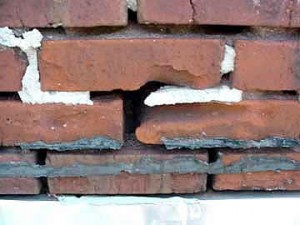The Science of Combustion
Ever wondered how a flame stays lit? Many fireplace owners have problems keeping their fire burning because they don’t know the basics of combustion. Here’s what you need to know:
Ever wondered how a flame stays lit? Many fireplace owners have problems keeping their fire burning because they don’t know the basics of combustion. Here’s what you need to know:

Molds can pose serious health risks to you and your family. Don’t allow them to flourish in your chimney. Make sure water and moisture stay out!
Mold is something you never want in your home, and most people think of the basement as the most common area for mold growth. However, if you have a leaky chimney with water penetrating your chimney walls, your chimney can be a prime spot for mold growth. Mold can spread quickly through your house, so if you have chimney mold, it should be removed as soon as possible to keep you and your family safe from the adverse health effects breathing in mold spores can cause. Chief Chimney Services would like to answer a few questions for you about chimney mold to inform you how to be on the lookout for a mold invasion of your fireplace and chimney.
According to the website Mold Advisor, unused fireplaces are the most common places for chimney mold to develop. The dark, damp, and poorly vented unused fireplace creates the perfect environment for mold to grow. The warm summer months, when you are not using your fireplace, is the perfect time for this to occur. The most likely fireplaces and chimneys to develop mold growth have leaks somewhere in the chimney because water is needed to allow mold to grow. Chief Chimney Services can not only take care of removing chimney mold, but we can also repair leaky chimneys to keep water out which lowers the possibility of mold to even occur.
If the mold has spread, you may see mold growing on the bricks of your outer fireplace or even on the walls or ceiling of the room that contains the fireplace. If you do spot mold growth on the outside of your fireplace or in the room, call Chief Chimney Services immediately to have us inspect the inside of your chimney for more mold. Most likely, the mold is unable to be seen because it is only growing on the walls of the inside of your chimney. However, you will probably notice the distinctive musty smell of mold coming from your fireplace. You and your family may also be suffering from respiratory problems due to breathing the mold. If you suspect chimney mold, again call us as soon as possible to inspect your chimney and fireplace and remove the mold.
In the beginning, mold can cause breathing problems similar to the common cold with sneezing, coughing, headache, runny nose, and a sore throat. However, prolonged breathing of mold spores can cause serious illnesses like asthma attacks, chronic sinusitis, allergic reactions, and pneumonia.
You are strongly advised to allow professionals like Chief Chimney Services to remove all of the chimney mold growth as it can be a hazardous job. However, if your doctor okays it, you can clean up any exterior mold from bricks by using an antifungal cleanser and a stiff brush. Be sure to wear a breathing mask when cleaning up mold.
If you have any other questions about chimney mold, contact Chief Chimney Services today. Our staff is happy to assist you quickly with this possibly dangerous problem.

If your masonry and/or firebox needs some repairs, call us and our experts will have it fixed in no time!
Masonry restoration is the phrase used for working with any form of masonry on an existing building or home that doesn’t encompass actually building it. Restoration runs the gamut from tearing the masonry down and rebuilding it from scratch to cleaning and sealing. One of the most commonly needed restoration projects is masonry and firebox repair. Keep reading to learn what this job involves and why it’s so critical.
The specific type of mortar used in fireboxes is called refractory mortar. However, don’t assume that your fireplace was built with this mortar. The chances of an older home actually having refractory mortar in the firebox are slimmer than the chances of a newer home. This is due in large part to changing building codes and the availability of the product. Many brick masons who constructed fireboxes in homes well into the 1990s used either a Portland-cement-based mortar or a self-concocted fireclay mortar (a mix of Portland cement, crushed fireclay, and sand).
Although both of these mortars were approved by building codes of the time, they haven’t fared well in homes in which the fireplaces are used regularly; the problem is simple: Portland cement doesn’t hold up well when subjected to the cycle of heating and cooling that occurs in a firebox. In an effort to combat this problem, most major building codes have added clauses requiring refractory mortar be used, as it doesn’t use Portland cement as a binder; instead, either calcium aluminate or sodium silicate is the binder. Over the long haul, refractory mortar performs far better than Portland-cement mortar and is more readily available than it was a few decades ago.
In order to repair damaged firebox mortar, you can take one of three approaches. The first approach involves simply scraping out and repointing the joints between the bricks with refractory mortar. The second approach involves applying a thin coat of refractory cement over the floor of the firebox. The final approach involves removing damaged bricks and replacing them with castable refractory cement. No matter which approach is taken, scrubbing the surface clean and vacuuming any dust before making the repair is critical.
Along with any part of your home, your fireplace requires maintenance to ensure your family’s safety during its use. A damaged firebox can be a potential fire hazard and should be repaired or replaced before using the fireplace again. At Chief Chimney Services, we work hard and pride ourselves on doing outstanding chimney and firebox repair and restoration work. The level of expertise of our CSIA-certified chimney sweeps is unmatched by anyone else on Long Island. No matter what your question or problem, we’re here to help! Contact us to schedule an appointment today.

A stinky chimney is an indicator of an even greater chimney problem that exists or can possibly exist in the future. To get to the bottom of it, let our experts at Chief Chimney help you out.
We all want the same things from our chimney systems. We want a chimney that vents properly and thoroughly. We want a firebox and flue that provides the protection from high heat that they were designed to provide. We want a system that keeps moisture from making its way into the interior of our chimney — and the interior of our home. And we want a chimney that doesn’t stink.
As CSIA-certified chimney professionals, Chief Chimney technicians are focused on helping our clients get all of that from their chimney systems — optimum performance, optimum levels of safety, minimum levels of moisture intrusion, and a pleasant absence of stink. If you’ve been frustrated by a stinky chimney, we can help.
The thing about chimney odor that we often don’t think about as we’re turning up our noses: It’s helpful, in a sense. That’s because ultimately, chimney odor is an indication that there’s a bigger problem going on in your chimney or with the use of your heating appliance.
If the smell you’re noticing is dirty, musty and dank, that’s most likely related to moisture, and very possibly is coming from mold growth. If you have mold or moisture, odds are you have a chimney leak.
Chief Chimney technicians can inspect your system thoroughly to figure out what’s allowing moisture to get into your chimney — which can be anything from a cracked chimney crown to damaged flashing, or something as simple as a missing chimney cap. When we find the culprit or culprits, we can make repairs to get rid of your leak — and get rid of that smell!
A Singed, Smoky Odor
Even though you’re routinely lighting a fire in your fireplace or stove, you shouldn’t smell a smoky odor in your home —your chimney is meant to carry away the byproducts that contribute to a smoky odor. So if you smell (or see) a lot of smoke when you’re using your appliance or in between uses, that’s an indication of a problem either with your venting system, or your burning practices.
If there’s a problem with your chimney’s draft — the upward movement of air that carries out combustion byproducts and smoke — you’ll most likely get an indication of that through a smoky stink. If you haven’t had the chimney swept in more than a year, there’s a good chance your problem is excess creosote buildup. But the problem could also have to do with chimney blockages, wind-induced downdrafts or a variety of other issues. We can inspect your chimney system to find your issue and correct it.
Smoky odors can sometimes just be the result of less-than-optimum burning practices, though — even something as simple as neglecting to open your flue completely during your fires.
Burning anything other than seasoned or kiln-dried cordwood — like wood that isn’t properly dried, trash or Christmas trees — can also cause your fire to produce excess smoke and excess creosote. In the case of burning green or moist wood, it can contribute to the development of troubling Glazed Creosote, which is extremely combustible, has a particularly strong odor and is really difficult to remove. If your flue has glazed creosote, we can remove it, and bring your system back to proper (and less stinky) condition.
If you have questions about the best burning practices and chimney odor problems, we’re always happy to help our valued clients. Just give Chief Chimney Services a call!
Your chimney liner will eventually wear down after years of usage. It is important to check its condition to know whether or not a relining or a replacement is needed.
If you are in the market for someone to handle your chimney maintenance needs, we want you to know that knowledge is power. Here are some questions you can ask prospective chimney sweeps to ensure that you hire the right professionals for the job.

Water in your chimney allows mold to thrive. This is not a good thing. Make sure to waterproof your chimney.
As chimney professionals, a lot of what Chief Chimney Services technicians will talk to homeowners about regularly focuses on preventing fire hazards, maintaining proper draft and keeping up with regular maintenance. It’s also important for us to talk about something that might seem a little less obvious with your chimney system: mold growth.
Mold can and will grow and spread just about anywhere it gets access to moisture and food (like the building materials that make up your home). So if moisture makes its way into your chimney — through damaged masonry or other damaged components — that dark, enclosed and moist space can make a perfect home for mold. Since our chimneys are largely dormant for months out of the year, and Long Island humidity contributes a healthy share of moisture just about year-round, we need to be particularly aware of chimney mold here.
Mold growth creates stains and smells, and those annoyances are reason enough to not want it in your home. But related health issues are more concerning. Airborne mold spores have been shown to contribute to a variety of health issues, including respiratory problems, skin and eye irritation and longer-term illnesses. Certain types of mold — so-called “black mold” — are toxic, and have been linked to severe issues from pulmonary illnesses to nerve damage and more. People who already struggle with asthma and other respiratory illnesses or have weakened immune systems have been found to be particularly susceptible to the effects of mold. So it’s important to know about mold growth, and to deal with it quickly if it’s found in your home.
It’s possible that you’ll see the signs of mold on or around your chimney — like discoloration of the masonry or adjacent building materials, or flaky and crystallized white efflorescence, which isn’t mold, but does point to a moisture intrusion problem. More often, though, if mold is growing inside your chimney where it isn’t in plain sight, the first indication will be a musty odor. We all know the smell of mold — it’s what most of us think of as that dank and unpleasant old-basement smell. If you notice an odor, Chief Chimney Services can inspect the chimney to assess whether there’s a moisture issue and mold growth.
Mold spores are everywhere, and if they get a dark space to thrive and moisture to feed on, they’ll grow. So mold growth in your chimney is a sure indication that there’s a moisture issue — and dealing with that moisture issue is the key to dealing with your mold.
The most effective way to get rid of chimney mold: Call Chief Chimney Services. Since breathing mold spores can be dangerous, it’s generally not advised to clean mold yourself on a space that’s any larger than 10 square feet (about a 3 by 3 square). If there’s mold growth inside your chimney, it’ll require special tools to properly get to it, as well. But beyond that, cleaning mold without addressing the moisture intrusion or leak issues is a temporary fix — the mold will grow back again. We can inspect and clean your chimney, find any leaks or moisture intrusion issues (which can be anything from degraded masonry to a cracked chimney crown or damaged flashing) and provide solutions and repairs.
If you have any questions or concerns about chimney mold, we’re always here to help. Just give Chief Chimney Services a call!

Your chimney should be a priority in your home maintenance checklist this Spring. Do this every year and you’ll have a longer lasting, efficient, and healthy chimney system.
We know how it goes: The weather starts to warm up, and your fireplace and chimney system heads out of your mind. It’s understandable to close your flue for the season and not want to think about your chimney until next fall. But making chimney care and maintenance part of your spring home checklist can make your life easier, and your chimney system perform better.
Here are a few spring chimney checklist suggestions we have at Chief Chimney Services, with a little bit of “why” behind them.
Every chimney system is different, but one thing we can tell you for sure: If you’ve been using your wood-burning fireplace or stove all fall and winter, your flue has creosote built up on its walls. As you burn wood, heated byproducts rise up to vent through your chimney, and your cooler chimney walls turn some of those gases back into liquid. That liquid layers and layers, and there you have it: creosote.
Ideally, you should have creosote removed during a chimney sweeping appointment before you start using the system over the next heating season. But here’s one reason why we think it’s preferable and better to make that appointment this spring: Your home will smell better all summer. That creosote has a smoky, sooty odor, and the heat and humidity of the summer brings that odor out. If you’ve ever noticed an acrid smell in your home during the summer — even though you haven’t used your fireplace in months — creosote is the source. Having your chimney swept in the spring means nicer-smelling air in the summer.
To properly maintain your chimney system, an annual chimney inspection is a must. And again, you’ll want to make sure it’s done before you start using your heating appliance when the weather cools again. But there are definite benefits to getting this work done early, in the spring.
First, you’ll catch Chief Chimney Services before our busiest season, which means you’ll have broader options for appointments. But also, when that first cool night comes around, you won’t have anything to think about — your system will already be ready for warm, cozy fires.
A lot of the chimney repairs we do at Chief Chimney are to the parts of your system that are designed to keep moisture out. Water is your chimney’s worst enemy, and we’ll do anything and everything we can to keep it from making its way in.
Moisture and your chimney’s relationship with it is something well worth thinking about in the spring, before the heavy rainy season rolls in. If a small problem in your chimney crown or chimney flashing has developed over the winter, spring rains can lead to chimney leaks and water damage to the interior of your home. Chief Chimney Services technicians can find those issues during a spring chimney inspection, and make any repairs necessary to arm the system against moisture intrusion again.
We can also recommend and apply a specially formulated waterproofing sealant for your masonry chimney that will significantly boost its ability to protect against water. Waterproofing keeps moisture from permeating the masonry itself, which not only keeps water out in the short term, but can protect your bricks and mortar joints in the long term.
If you have any questions about chimney maintenance and care — including making that part of your spring routine — Chief Chimney Services is always here to help. Give us a call!

Pay close attention to the warning signs displayed by your chimney. Have it inspected as soon as possible.
When you aren’t feeling well you often times will go see a doctor. Your chimney however, cannot tell you when it is not in top shape so you need to watch for the warning signs that come along with the need for chimney maintenance. Also, you should have at least one chimney sweep and inspection every year. If you sense that something is going wrong inside of your chimney it is important to call your trusted technician immediately. If you need someone, the professionals at Chief Chimney Services!
After the winter season cracks can begin to form in the chimney’s structure from the constant freezing and thawing of precipitation. This can cause the caulk to crack and water to have a place to collect. This water can turn to mold in as little as one or two days. With careful chemical treatments, mold can be removed. Most technicians will recommend waterproofing after the chimney is back in order to prevent similar instances in the future.
When creosote is released from firewood it clumps together and slowly begins to block your chimney. When temperatures get warm and humid, the clumps will begin to cause a foul odor. Most people think that having a sweep will rid the odor, but in actuality it will only reduce it once the creosote has had time to soak into the structure. This is one reason you should keep your maintenance up to date.
Also, blockages caused by creosote can cause draft problems. When this happens air cannot properly exit the home and the room will fill with smoke. This can also lead to Carbon Monoxide poisoning which can be fatal.
When hiring a techinican it’s important to make sure you have the right person. The Chimney Safety Institute of America (CSIA) has a few suggestions on how to hire the best for your chimney. Check how long the company has been in business. Also check to see if they have references or reviews from real clients. Lastly, make sure they are CSIA certified.
You have nothing to worry about when your chimney gets its inspection. A few things you can do to help with the process is to not burn a fire for 24 hours and clean the area around the fireplace where the technicians have room to work. Also, lock up all pets for their safety.

Is your chimney not working the way it should? Perhaps a part or two needs to be replaced. Get an inspection now.
It may look simple from the outside, but your masonry chimney system is a lot more than a tall stack of bricks. And your prefabricated chimney system is a lot more than a long pipe.
Inside and out, a chimney system is a complex collection of parts designed to hold in combustion byproducts, encourage draft, protect against heat, protect against water intrusion or some combination of several of those. And like any complex collection of parts — from a car engine to a kitchen appliance — from time to time, a part will need replacing. That’s where Chief Chimney Services comes in.
Our CSIA-certified technicians have been serving homeowners in Suffolk County for decades — there isn’t a chimney repair we haven’t tackled a dozen times over, and we take pride providing our clients with the kind of top-notch care that comes with extensive training and extensive experience.
Whatever needs replacing in your system, we’re here to help. But if you’re curious about some of the more common chimney part replacement jobs we perform, here’s a quick rundown:
Chimney caps need to be made out of strong and durable material (stainless steel and copper are exceptional choices), and they need to be properly sized and installed to do their important job effectively. That job is multi-pronged: First, chimney caps help to keep moisture out of the chimney by closing off the top of the flue. Second, a strong, properly sized cap helps keep animals, including birds and many mammals, from moving into your chimney to nest, causing damage and a host of annoying problems. Beyond that, some specialized caps can help with performance issues, like downdrafts. If you have a damaged galvanized cap, or you’ve lost a chimney cap in a bad storm, our technicians can help you find the perfect replacement, and install it to last.
Chimney flashing plays a hugely important role in your system, and its installation is meticulous work, custom-designed and -fitted for every individual chimney. It needs to be custom-installed to be effective — flashing is tightly fitted, in layers, around your chimney where it meets the roofline, to keep water from making its way into that seam. So the installation needs to be free of gaps and snug to be watertight and durable. Sometimes serious windstorms can tear pieces of flashing off, which makes replacement necessary. And when flashing is improperly installed to start off with, leaks and the need for replacement flashing generally follow.
Many older chimneys have what’s called a throat damper installed deep in the chimney, and it closes off the flue down above the firebox when you’re not having a fire. These use a metal plate to cover up the flue opening, and that doesn’t provide a particularly effective seal to start off with. Over time, those dampers can also corrode, crack, get stuck or the plate can get dislodged from the track that it sits on. Throat dampers can sometimes be repaired, but replacing that damper with an energy top damper– installed up at the top of the flue — can make a much better choice. These completely close off the flue with a silicone gasket, keeping air transference to a minimum and helping you save money and fuel by increasing your system’s energy efficiency.
Those are just a few of the more common replacement parts we install. Chief Chimney techs can handle any and all chimney repair or replacement jobs that you might need — just give us a call!